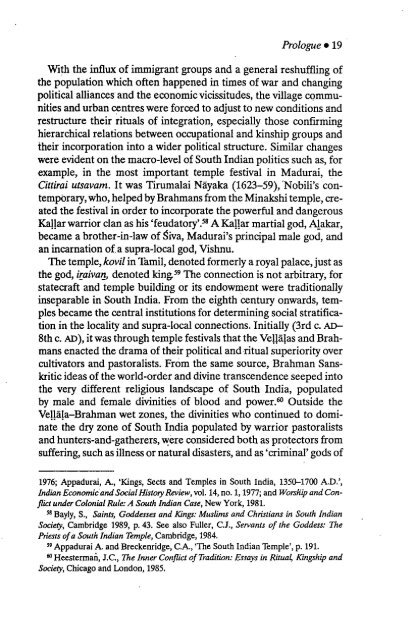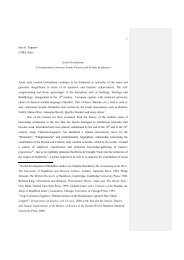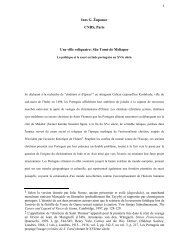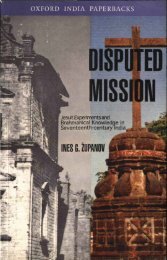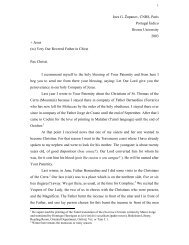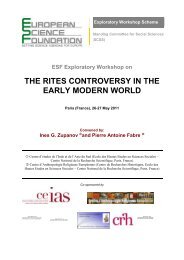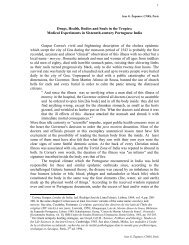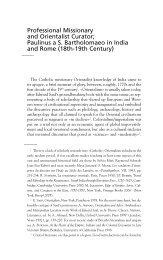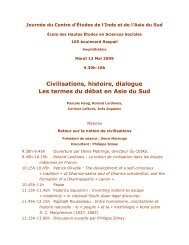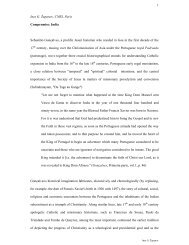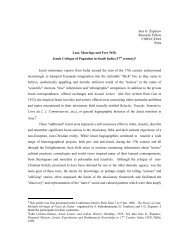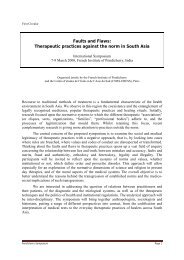INES G. ZUPANOV - Ines G. Županov
INES G. ZUPANOV - Ines G. Županov
INES G. ZUPANOV - Ines G. Županov
Create successful ePaper yourself
Turn your PDF publications into a flip-book with our unique Google optimized e-Paper software.
Prologue • 19<br />
With the influx of immigrant groups and a general reshuffling of<br />
the population which often happened in times of war and changing<br />
political alliances and the economic vicissitudes, the village communities<br />
and urban centres were forced to adjust to new conditions and<br />
restructure their rituals of integration, especially those confirming<br />
hierarchical relations between occupational and kinship groups and<br />
their incorporation into a wider political structure. Similar changes<br />
were evident on the macro-level of South Indian politics such as, for<br />
example, in the most important temple festival in Madurai, the<br />
Cittirai utsavam. It was Tirumalai Näyaka (1623-59), Nobili's contemporary,<br />
who, helped by Brahmans from the Minakshi temple, created<br />
the festival in order to incorporate the powerful and dangerous<br />
Kaljar warrior clan as his 'feudatory'. 58 A Kallar martial god, Alakar,<br />
became a brother-in-law of áiva, Madurai's principal male god, and<br />
an incarnation of a supra-local god, Vishnu.<br />
The temple, kovil in Tamil, denoted formerly a royal palace, just as<br />
the god, iraivan, denoted king 59 The connection is not arbitrary, for<br />
statecraft and temple building or its endowment were traditionally<br />
inseparable in South India. From the eighth century onwards, temples<br />
became the central institutions for determining social stratification<br />
in the locality and supra-local connections. Initially (3rd c. AD-<br />
8th c. AD), it was through temple festivals that the VeHäjas and Brahmans<br />
enacted the drama of their political and ritual superiority over<br />
cultivators and pastoralists. From the same source, Brahman Sanskritic<br />
ideas of the world-order and divine transcendence seeped into<br />
the very different religious landscape of South India, populated<br />
by male and female divinities of blood and power. 60 Outside the<br />
Vejläla-Brahman wet zones, the divinities who continued to dominate<br />
the dry zone of South India populated by warrior pastoralists<br />
and hunters-and-gatherers, were considered both as protectors from<br />
suffering, such as illness or natural disasters, and as 'criminal' gods of<br />
1976; Appadurai, A., 'Kings, Sects and Temples in South India, 1350-1700 A.D.',<br />
Indian Economic and Social History Review, vol. 14, no. 1,1977; and Worship and Conflict<br />
under Colonial Rule: A South Indian Case, New York, 1981.<br />
58 Bayly, S., Saints, Goddesses and Kings: Muslims and Christians in South Indian<br />
Society, Cambridge 1989, p. 43. See also Fuller, C.J., Servants of the Goddess: The<br />
Priests of a South Indian Temple, Cambridge, 1984.<br />
39 Appadurai A. and Breckenridge, C.A., 'The South Indian Temple', p. 191.<br />
60 Heesterman, J.C., The Inner Conflict of Tradition: Essays in Ritual, Kingship and<br />
Society, Chicago and London, 1985.


